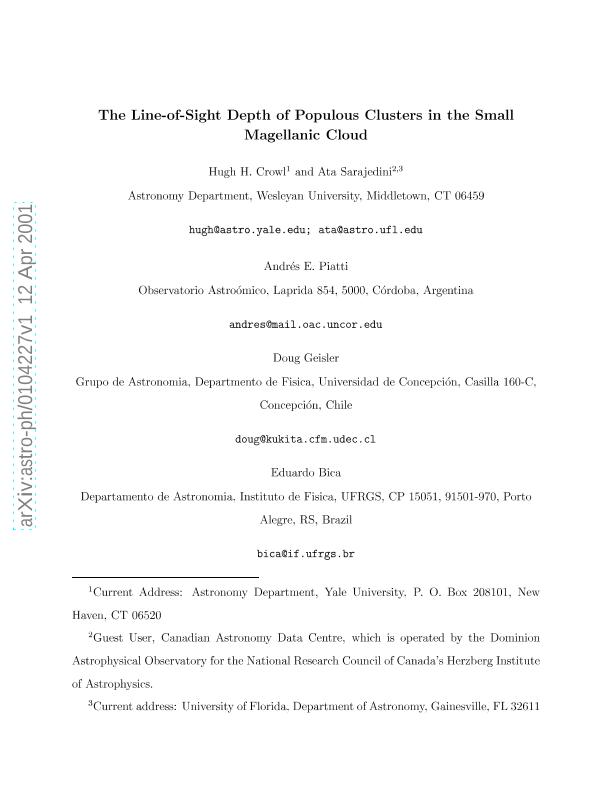Mostrar el registro sencillo del ítem
dc.contributor.author
Crowl, Hugh H.
dc.contributor.author
Sarajedini, Ata
dc.contributor.author
Piatti, Andres Eduardo

dc.contributor.author
Geisler, Doug

dc.contributor.author
Bica, Eduardo

dc.contributor.author
Claria Olmedo, Juan Jose

dc.contributor.author
Santos Jr., João F. C.

dc.date.available
2017-08-15T16:57:18Z
dc.date.issued
2001-07
dc.identifier.citation
Crowl, Hugh H.; Sarajedini, Ata; Piatti, Andres Eduardo; Geisler, Doug; Bica, Eduardo; et al.; The line-of-sight depth of popuous clusters in the Small Magellanic Cloud; IOP Publishing; Astronomical Journal; 122; 1; 7-2001; 220-231
dc.identifier.issn
0004-6256
dc.identifier.uri
http://hdl.handle.net/11336/22468
dc.description.abstract
We present an analysis of age, metal abundance and positional data on populous clusters in the Small Magellanic Cloud (SMC) with the ultimate aim of determining the line-of-sight (LOS) depth of the SMC by using these clusters as proxies. Our data set contains 12 objects and is limited to clusters with the highest-quality data for which the ages and abundances are best known and can be placed on an internally consistent scale. We have analyzed the variation of the clusters´ properties with position on the sky and with LOS depth. Based on this analysis, we draw the following conclusions: (1) The observational data indicate that the eastern side of the SMC (facing the large Magellanic Cloud) contains younger and more metal-rich clusters as compared with the western side. This is not a strong correlation because our data set of clusters is necessarily limited, but is suggestive and warrants further studyl. (2) Depending on how the reddening is computed to our clusters, we find a mean distance modulus that ranges from (m-M)o = 18.71 +/- 0.06 to 18.82 +/- 0.05. (3) The intrinsic +/- 1 sigma LOS depth of the SMC populous clusters in our study is between 6 and approximately 12 kpc, depending primarily on whether we adopt the Burstein & Heiles reddenings or those from Schlegel et al. (4) Viewing the SMC as a triaxial galaxy with declination, right ascension and LOS depth as the three axes, we find axial ratios of approximately 1:2:4. Taken together, these conclusions largely agree with those of previous investigator sand underscore the utility of populous star clusters as probes of the structure of the SMC.
dc.format
application/pdf
dc.language.iso
eng
dc.publisher
IOP Publishing

dc.rights
info:eu-repo/semantics/openAccess
dc.rights.uri
https://creativecommons.org/licenses/by-nc-sa/2.5/ar/
dc.subject
Small Magellanic Cloud
dc.subject
Star Cluster
dc.subject
Photometry
dc.subject.classification
Astronomía

dc.subject.classification
Ciencias Físicas

dc.subject.classification
CIENCIAS NATURALES Y EXACTAS

dc.title
The line-of-sight depth of popuous clusters in the Small Magellanic Cloud
dc.type
info:eu-repo/semantics/article
dc.type
info:ar-repo/semantics/artículo
dc.type
info:eu-repo/semantics/publishedVersion
dc.date.updated
2017-08-14T19:51:34Z
dc.journal.volume
122
dc.journal.number
1
dc.journal.pagination
220-231
dc.journal.pais
Reino Unido

dc.journal.ciudad
Londres
dc.description.fil
Fil: Crowl, Hugh H.. Wesleyan University; Estados Unidos
dc.description.fil
Fil: Sarajedini, Ata. Wesleyan University; Estados Unidos
dc.description.fil
Fil: Piatti, Andres Eduardo. Consejo Nacional de Investigaciónes Científicas y Técnicas. Oficina de Coordinación Administrativa Ciudad Universitaria. Instituto de Astronomía y Física del Espacio. - Universidad de Buenos Aires. Facultad de Ciencias Exactas y Naturales. Instituto de Astronomía y Física del Espacio; Argentina
dc.description.fil
Fil: Geisler, Doug. Universidad de Concepción; Chile
dc.description.fil
Fil: Bica, Eduardo. Universidade Federal do Rio Grande do Sul; Brasil
dc.description.fil
Fil: Claria Olmedo, Juan Jose. Universidad Nacional de Cordoba. Observatorio Astronomico de Cordoba; Argentina
dc.description.fil
Fil: Santos Jr., João F. C.. Universidade Federal do Minas Gerais; Brasil
dc.journal.title
Astronomical Journal

dc.relation.alternativeid
info:eu-repo/semantics/altIdentifier/url/http://iopscience.iop.org/article/10.1086/321128
dc.relation.alternativeid
info:eu-repo/semantics/altIdentifier/doi/http://dx.doi.org/10.1086/321128
dc.relation.alternativeid
info:eu-repo/semantics/altIdentifier/url/https://arxiv.org/abs/astro-ph/0104227
Archivos asociados
